Antler History
*History obtained from the Antler Golden Jubilee booklet & the 1989 Antler School Reunion booklet.
It has not been edited or updated.
Antler town site was owned and plotted by the Tallman Investment Company in May or June of 1905. The business district is in the pattern of a square with a large building constructed in the center. The center building contained the First National Bank and the Post Office.
Town lots were offered for sale at the International Bank of Westhope on July 11, 1905 at 9 o’clock. They were sold for $500.00 each and over $17,000.00 worth of lots were sold.
The railroad was being constructed from Westhope to Antler during the summer of 1905. As the railroad did not reach Antler until the middle of August many loads of lumber were hauled by horse and wagon from Westhope, Sherwood and Mohall. During the summer and fall construction work was at its’ peak. In August Antler was said to have twice as much plate glass as any other town in North Dakota.
The first train left Antler on August 20, 1905 and it was hoped that the town would now have better mail service. They had received mail only twice a week up to this time.
The first load of grain to be received at Antler was at the National Elevator in September 1905.
By December of 1905 there were 40 businesses in Antler. Among these were a newspaper office, 3 banks, 4 drug stores, 2 hardware stores, a hotel, several rooming houses, a meat market, department and drugstores, restaurants, various shops (bakery, millinery, jewelry/optical, barber, harness and implement), a photo studio, a poolroom, an opera house, telephone office and customs office. There were offices of several physicians, a dentist and a realtor. There were several lumber yards, a blacksmith, livery barns, elevators and a feed mill. At one time there were lawyers, an undertaker, a veterinarian and a motion picture theater.
Antler City Government
The first village election was held in April of 1906 with 25 votes cast. M.D. Dyar, W.C. Derby, F.A. Rinkle, A.A. Kleinert and Chas. DeMars were elected to the Board of Trustees for a term of 1 year. Each was paid the sum of $1.00 for each meeting attended. Fred Probart was the clerk, J.B. Stewart was the treasurer, R.S. Dawly was the assessor, J. Moses was the marshal and C.A. Stratton was the justice.
One of the first matters of business was to purchase land for a dump or nuisance ground. Four acres of land in Section 11 were bought from J.A. McFarland for $125.00. It is noted that they gave the Great Northern Railroad permission to lay a water pipe on Neva Street through the village of Antler so water could be pumped from Antler Creek for the railroad. A dam was constructed at the creek at this time.
Residents in Antler have had telephone service since 1906. The Westhope Telephone, Light and Power Company provided the phone service until 1928. At this time William Clifford of Dakota Service Company of Mohall was given a franchise to maintain and operate telephone service in Antler. Souris River Telephone has provided telephone service to Antler and the area since 1956 or 1957.
On August 27, 1907 it was decided they needed a fire hall. A bid of $99.00 from Ogg & Mitchell was accepted but they were actually paid $139.00. The fire bell was purchased for $66.23 and the stove cost $46.20. A 16’ x 16’ jail was also put in this building.
A city election was held on March 7, 1908 to change the Village of Antler to a city. Forty-eight votes were cast. Thirty-nine were in favor of incorporation as a city, five were opposed and four ballots were thrown out. W.C. Derby was president of the board at this time and the population was 520.
Antler must have had its’ share of criminals, as in 1924 I.C. Reeves was appointed as Special Marshall for the purpose of curbing lawlessness, drunkenness and disorderly conduct. He would receive $5.00 for each and every arrest followed by conviction.
Many improvements were being made in the city in its’ early years. Trees were planted in all parts of the city. Sidewalks and crossings were built. Streets were graded. It was noted that sidewalks had to be 10 feet wide and not less than 2” x 6”. In June 1910 a sidewalk was built from Gertrude Street all the way to the school house. A small road grader was purchased by the city in 1911 to help keep the streets in good condition. Street lamps were bought for $257.10 and John Fishback was paid $12.50 for setting them up in 1911. These were to be lighted every evening from 8:00 to 10:30.
For a few years Antler had its’ own light plant and William H. Wegner was paid a salary of $60.00 per month to run the plant. In 1929 the City Council granted M.A. Erickson permission to furnish power to Antler. Electricity for the city is now furnished by Otter Tail Power Co.
In 1939 the City of Antler received the deeds for the Krueger lots for a city park. In 1940 an application was made for a WPA project to landscape the city park. Picnic tables, swings and a sand box have been put in the park to make it a very inviting place for a picnic.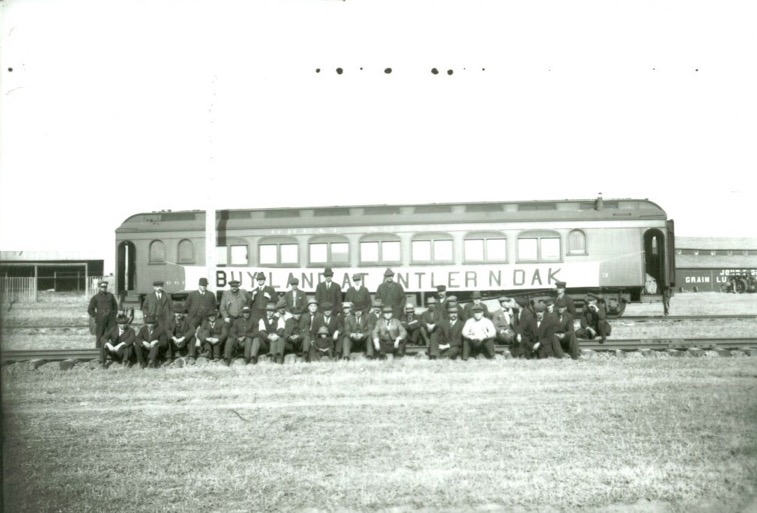
The Opera House
Every town has a place that is the center for entertainment. The Opera House has been the scene of many activities in Antler from political rallies, plays, dances, bingo games to basketball games. James Hetland operated it as a public dance hall in 1925. The city council voted to prohibit the Charleston dance in the Opera House on April 6, 1926. The City bought the Opera House from the Antler Holding Company for $150.00 in 1935. A city election was held in April 1936 which approved a $2000.00 bond issue for reconstruction of the hall. In 1937 the hall was leased to William T. McCarthy of Fargo and he erected a booth for moving pictures. Fifty four seats were purchased for the hall at a cost of $67.50. In November 1939, Father Ryan leased the hall for motion pictures. Clint Howery also leased the hall for a time. Local business men rented the hall for Saturday night dances during the winter months. In 1941, Jean Cranston was paid for painting a screen for the hall.
The hall was used by the school for basketball, plays and carnivals until the school gym was built in 1950.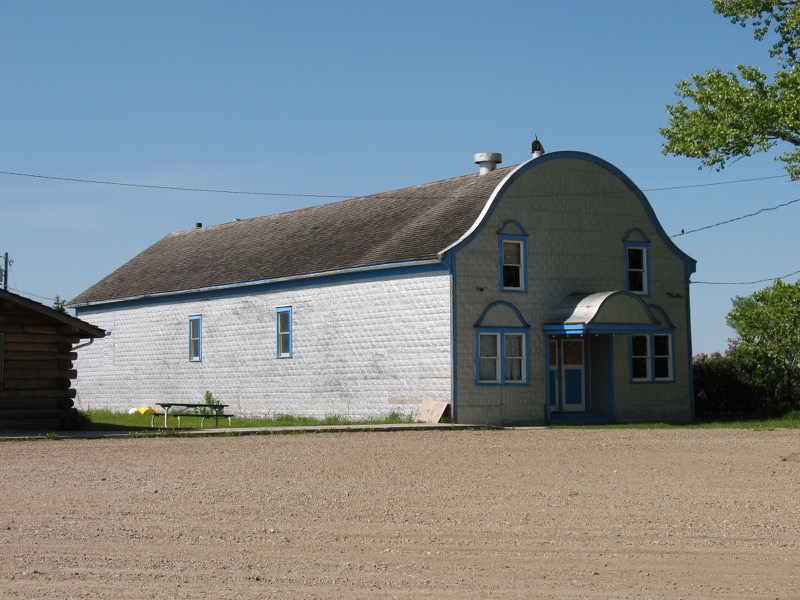
More History
Many say our fair village derived its name from the Antler Creek which is one of two tributaries branching from the Mouse River. The Indians called the Mouse River the "Moose", and these two tributaries were the "Antlers of the Moose". Others say that Antler was named for the herds of deer and antelope that grazed upon these plains before the white man came.
Antler is located in Antler Township in the northwest corner of Bottineau County, one and one half miles south of the Canadian border and fifty miles north of Minot.
Antler's population was 520 when it incorporated into a city in 1905; but since the outbreak of the war, it has dwindled to 162 because of the emigration of defense workers.
The altitude of Antler is 1543 feet above sea level. Antler is situated on a prairie from which one can see for miles in any direction except north. There the view is obstructed by woods running along the banks of the Antler Creek.
The first industry was farming on a small scale, later settlers took up ranching. Wheat is the chief crop, although flax, rye, oats, and barley are also raised.
The first white settlers came to Antler territory about 1889. Some of these early settlers were Mr. and Mrs. James Schell, Jack, Mike and Dan Manning, and Robert Wright. The first house in this territory was built on the creek bank west of Sam Howery's house. Its steps leading down to the creek can still be seen. Because of its whitewash and its solitary situation, it became a landmark for the Indians, who called it the "White House". They had seen the White House in Washington, D.C., when taken there on a charge concerning the death of Custer. The creek was a famous battlefield for the Indians. There were two tribes: The Sioux in the United States and a tribe from Canada. James Schell's house, the oldest house in Bottineau County, was built in 1889. It was built by Jack Sieffert, but because of a hail storm, it was not finished, and has remained the same ever since.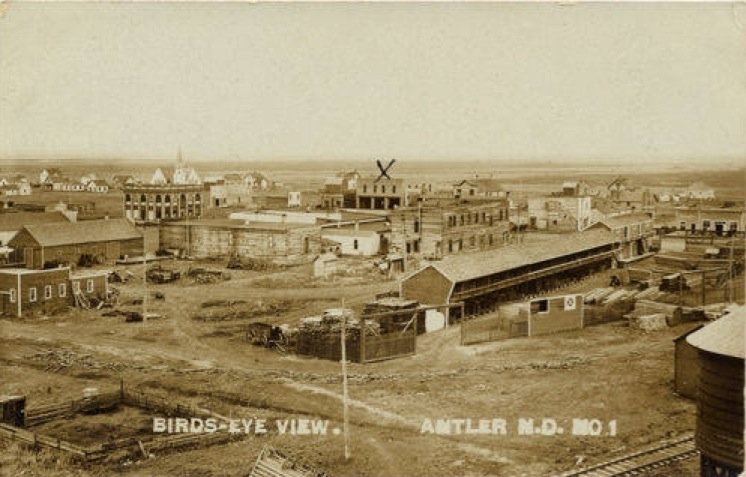
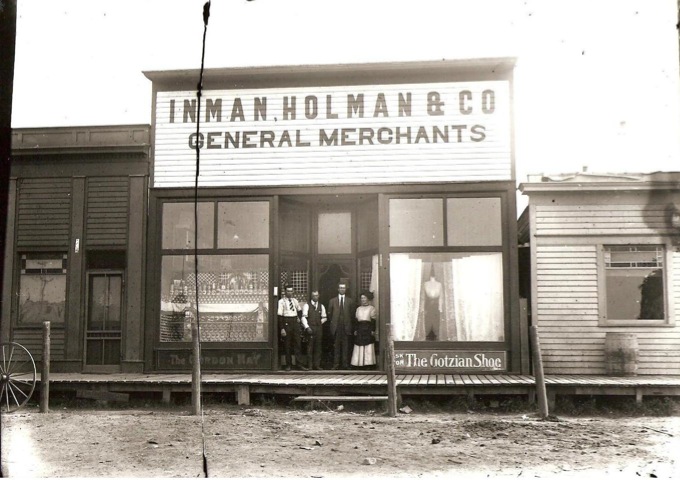
In 1904 Westhope was a new town, and in 1905 Antler had just begun.
Mr. W. Wegner, who came from Casselton, North Dakota, is the only original business man still living in Antler.
At first he was engaged in the drug business and occupied the south half of the building which was Krueger's at the time.
Mr. Wegner recalls: "John Zeigler had the first store and post office just south of Charley Young's well. It -- the Boston Store -- was later moved to the building that was Kvalvik's Garage. The building in which A. N. Nelson lives was a printing shop, where the Antler AMERICAN, a weekly newspaper, was published. The lots east of Nelson's Store, that was then Inman - Holman, were filled with business places.
"The corner building where Don Shuman had his tavern was the Dick Bennet Drug Store and the building next to it was a general store, later operated by Irwin. The place Erling Tennyson has for his beer parlor was then a pool room. There were two buildings south of Fox's Meat Market -- a hardware store and an implement shop. The hall was built in later.
Waxy Kleinert had the first meat market, and later Wm. Haugh was our butcher until he sold out to Fred Fox in 1927. Ed Howley had a barber shop in the building that Floberg’s occupy.
"The building I have was used as a temporary First National Bank until the building where Dewey's Store is was built. The next building was the drug store and Krueger's Furniture Shop, and the one north of that was the town undertaking parlors operated by Holman and Krueger. The rooming house building was built by Golden and operated by Brown.
The building where Lytle’s now live was a photograph studio and later a bakery operated by Mrs. McLeod. The Engman Hardware was run and owned by Roy Haliday.
The northwest corner of the square was vacant until the fire hall was built in 1907 and was followed later by the Lodge Hall.
"The Savory Hotel was owned by Charles Eyestone and later bought by James Newton. There was a cafe on the lot that Haugh's Service Station occupies.
Town lots were worth around $500 at one time and were owned by the Tolman Investment Company.
"The first town site was where the Carpenter place was, north of Thorleif Tennyson's but because the land was too low, the site was moved.
Sam Howery moved the first house to town: it is the one occupied by Carl Andersons."
M.D. Dyar says: "There were four elevators at first. Jim McFarlane bought grain for St. Anthony, Charley Bready for the National, Pete Byers for the Gruebar and I for the McCabe.
The railroad was extended to Antler in September 1905 and George Withey ran the first train here. R.C. Wynn was the conductor."
Postmaster Ben Wright recalls: "In 1897 the first post office was built on the creek with Dunc McClain as postmaster. He had the building in which Ted Himle's now reside as the post office.
Our first depot agent was Grace Pellman, the mother of Martha and Buster Manning."
"Dr. J.A. Perrin was a residential doctor here and we had two residential pastors: Reverend Shields of the Presbyterian Church and Reverend Pratt of the Methodist Church were among the first.
There were two blacksmiths: William Manning and Buckman."
A number of changes have taken place in Antler and the surrounding community since boom days.
Many of the old buildings have been moved or destroyed by fire, and there have been few to replace these.
Fires have caused considerable loss. There were, at one time, six elevators in operation. Four have been destroyed by fire and the remaining two are combined. The last fire occurred on July 6, 1943, about 6 PM when the former Dyar elevator operated by William Ballance burned to the ground. The Silke Garage fire on January 1, 1944, was a tragedy for a business that was an asset to the community.
This garage was built about 1909 or 1910 by Dyar, Rinkle, and Johnson. Fords cost about $500.00 at that time.
The Withey house, Hubbard house , Section house dwelling owned by Holman, A.V. Smith house, the Artz home and the elevator residence have all been moved out of town.
To supply recreation, Antler community was tops at one time. The Antler Park and Pavilion served picnickers well and the theater has been operated at intervals until two years ago.
Seasonal swimming in the creek is enjoyed. Now most of the recreation is provided by the school.
Many changes have taken place since 1944. In 1953-54 a new grain elevator was built to replace one which was later torn down. In 1975 the Rural Fire Department built a large building which houses the fire hall, a community center with a kitchen and the post office. In the spring of 1989 an additional kitchen and storage room were constructed on the west side of the community center section.
In 1980 the city had 2 gas stations, 2 bars, a grocery store, a hardware store, an elevator, a recreation center, a county shop, a post office, 2 churches, the school and the community center.
A single fire destroyed the 2 bars in 1984. The same year a new bar and a steak pit were built.
Railroad service to Antler was discontinued in 1985 due to a lack of business. The tracks were later removed.
Some recent improvements are the installation of a water system and a sewer system. Several older buildings have been renovated and a portion of the main street leading into Antler from the south has been paved.
At the present time, in 1989, there is a grocery store, a bar and steak pit, a post office, a garage and gas station, a county shop, a grain elevator and one church, the Antler Community Church.
The population of Antler in the 1980 census is listed as 101 residents.
Trutna Store in 1906 (submitted by Rick Trutna)
Trutna Store in 1906 (submitted by Rick Trutna)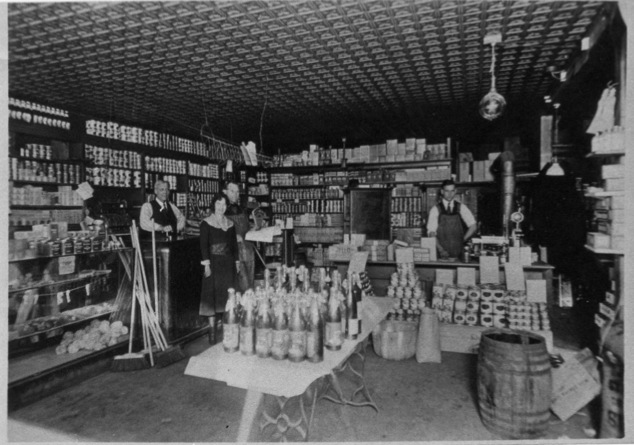
Copyright 2007-2020
Mark Jorgensen
All Rights Reserved
Terms Of Use